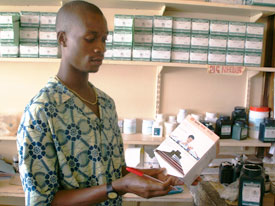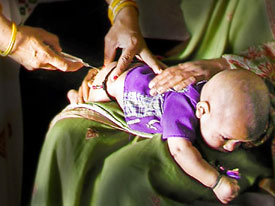Fogarty study shows poor quality malaria drugs pose threat
May / June 2012 | Volume 11, Issue 3

Photo by Arturo Sanabria, courtesy of Photoshare
A Fogarty survey showed many African countries
have insufficient resources to monitor the quality
of antimalarial drugs.
Poor quality antimalarial drugs lead to drug resistance and inadequate treatment that pose an urgent health threat, according to a Fogarty study published recently in
The Lancet Infectious Diseases journal. Emergence of malaria strains that are resistant to artemisinin drugs on the Thailand-Cambodia border make it imperative to improve the drug supply, stressed the authors.
"Poor quality antimalarial drugs are very likely to jeopardize the unprecedented progress and investments in control and elimination of malaria made in the past decade," according to Gaurvika M.L. Nayyar, a Fogarty scientist and lead author on the paper.
By studying survey data of the malaria drugs available across Southeast Asia and sub-Saharan Africa, researchers found that from 20 to 42 percent are either poor quality or fake. Poor quality samples were classified as falsified, substandard or degraded. Falsified drugs were fraudulently manufactured with fake packaging and usually no or wrong active ingredient. Substandard products were poorly manufactured with inadequate or too much active ingredient. Degraded supplies are good quality drugs that have been compromised by substandard storage.

Photo by Kailash Mittal, courtesy of Photoshare
About one-third of malaria drugs tested in Southeast
Asia were found to be fakes, according to a Fogarty
study
Multicountry surveys from seven Southeast Asian countries included data on 1,437 samples of malaria drugs. About one third failed chemical analysis, nearly half were not correctly packaged and 36 percent were fakes. Similar surveys from 21 countries in sub-Saharan Africa provided data on 2,634 malaria drug samples. Of these, more than one third failed on the basis of chemical analysis and about 20 percent were found to be fakes. Only Burkina Faso provided data on packaging analysis, with about a 35 percent failure rate.
Most of the world’s 655,000 to 1.2 million deaths from malaria each year are preventable - if patients receive authentic drugs in appropriate dosages, early enough.
In regions where malaria is prevalent, antimalarial drugs are widely distributed and self-prescribed, incorrectly or correctly. The study found there are insufficient facilities to monitor the quality of antimalarial drugs and poor consumer and health worker knowledge about the therapies. In addition, there is a lack of regulatory oversight of manufacturing and little punitive action for counterfeiters, the paper's authors contend.
Poor quality antimalarial drugs widespread
|
Sub-Saharan Africa | 35% | 36% | 20% |
|---|
|
Southeast Asia | 35% | 46% | 36% |
|---|
No reliable global estimates are available on the extent of poor quality antimalarial drugs because there are no internationally accepted definitions of different types of inadequate drugs, no standard testing protocols or drug content requirements and no recognized international forum to provide technical and scientific oversight, the study reported.
A 2010 World Health Organization (WHO) survey highlighted the hurdles African medicine regulatory authorities face in tackling the problem. Agencies lack sustainable funding, face chronic staff shortages, and have few or no operational resources.
Improved monitoring of malarial drugs will help spotlight the urgent need for action, according to the study. One group working on this is the
Worldwide Antimalarial Resistance Network, which is developing an online method to provide data on poor quality drugs.
Artemisinin derivatives are the most effective drugs against malaria, which is why scientists are so concerned about reports from western Cambodia that there are signs of resistance or tolerance to them. Modeling analyses suggest underdosing of patients, through poor quality or fake drugs, can play an important part in the spread of drug resistance.
"These findings are a wake-up call demanding a series of interventions to better define and eliminate both criminal production and poor manufacturing of antimalarial drugs," Nayyar stated.
More Information
To view Adobe PDF files,
download current, free accessible plug-ins from Adobe's website.